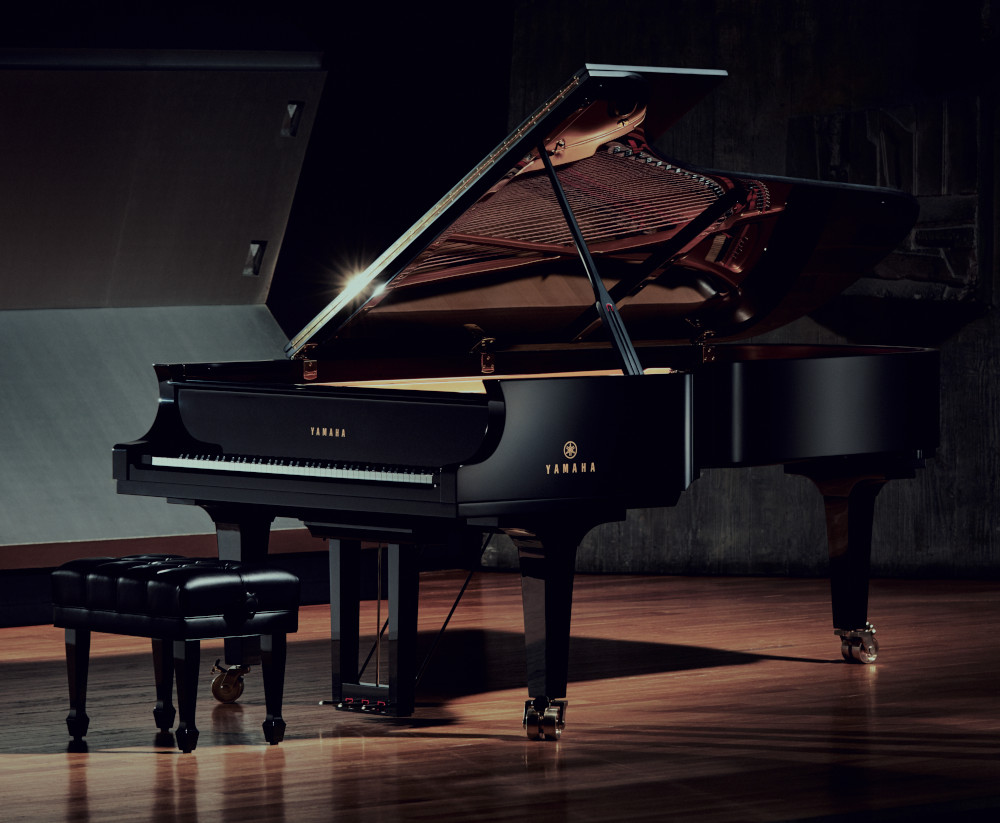
I used to have a teacher who would frequently say, “For every single grade point PAST 80%, it takes as much effort as the FIRST 80.” I believe this statement to be true from experience. The first 80 is the easiest. Chipping away at every point past that is the challenge. The bulk of the work can bring a project into shape but it’s the pursuit of excellence, that’s where the challenge lies.
 Yamaha is one such company that dedicates substantial commitment in resources to consistent research and development to refine their pianos. What’s interesting to note and what I’ve begun to realize is that the learning, the growing, the adapting and changing never stops with Yamaha. Rather than resting on the laurels of their previous models, preparation begins for the next model almost immediately after the current model has been released. There have been only 5 significant releases in their concert grand in just over 50 years. And it just so happened quietly in 2022 that the latest CFX release took place. It wasn’t until the last NAMM show that I had the wonderful opportunity to sit in front of the latest version CFX with product specialist, Heratch Touresian that I learned of some of the details of their refinements.
Yamaha is one such company that dedicates substantial commitment in resources to consistent research and development to refine their pianos. What’s interesting to note and what I’ve begun to realize is that the learning, the growing, the adapting and changing never stops with Yamaha. Rather than resting on the laurels of their previous models, preparation begins for the next model almost immediately after the current model has been released. There have been only 5 significant releases in their concert grand in just over 50 years. And it just so happened quietly in 2022 that the latest CFX release took place. It wasn’t until the last NAMM show that I had the wonderful opportunity to sit in front of the latest version CFX with product specialist, Heratch Touresian that I learned of some of the details of their refinements.
A brief history of Yamaha’s Concert Line
In 1967 Yamaha created their first concert grand called the CF
16 years later
1983 Yamaha introduced the CFIII concert grand
8 years later
1991 The CFIIIs was shown
19 years later
2010 The now popular CFX was unveiled
12 years later
2022 The CFX saw the release of its most refined release Yamaha to date
The CFX in 2010 was a very clear lane change for the Yamaha concert grand. Throughout the 80’s and 90’s, Yamaha produced a signature, recognizable sound. It was powerful and bright and became a favorite amongst many pop and classical recording artists. But with the release of the CFX, it was apparent that Yamaha was in pursuit of a more versatile and expressive piano. The most notable changes for me were the difference in hammer felt and piano wire, combined with a wonderfully live soundboard, resulting in greater depth in timbre, more control in color, a wider palette for expression. It’s a wonderful sensation where you can play both felty, intimate sounds and gradually turn up the heat to reveal bold and more strident sounds.
As of 2022, the CFX has undergone substantial changes. But from the outside, this latest version of the CFX looks almost identical. The most obvious differentiating visual feature being the music rack. But that is, just the tip of the iceberg. After a dozen years, with feedback from 100 contributing concert artists, Yamaha began making model after model until they had produced 30 prototypes! It’s a tricky balance modifying a piano because all of the parts are inextricably linked and one change sets in motion a whole other set of spinoff reactions. For example, to create certain tonal characteristics, you might change the density of the hammer felt. In doing so, it can alter the touchweight and how you play the piano. A slightly heavier hammer has greater impact on dynamic range etc. but also how the performer feels performing rapid passages. All that to say, the changes in every department from rim construction to hammer production to cast iron forging to wire chemical formulas – all departments need to interact to create a balanced approach that caters to the performer.
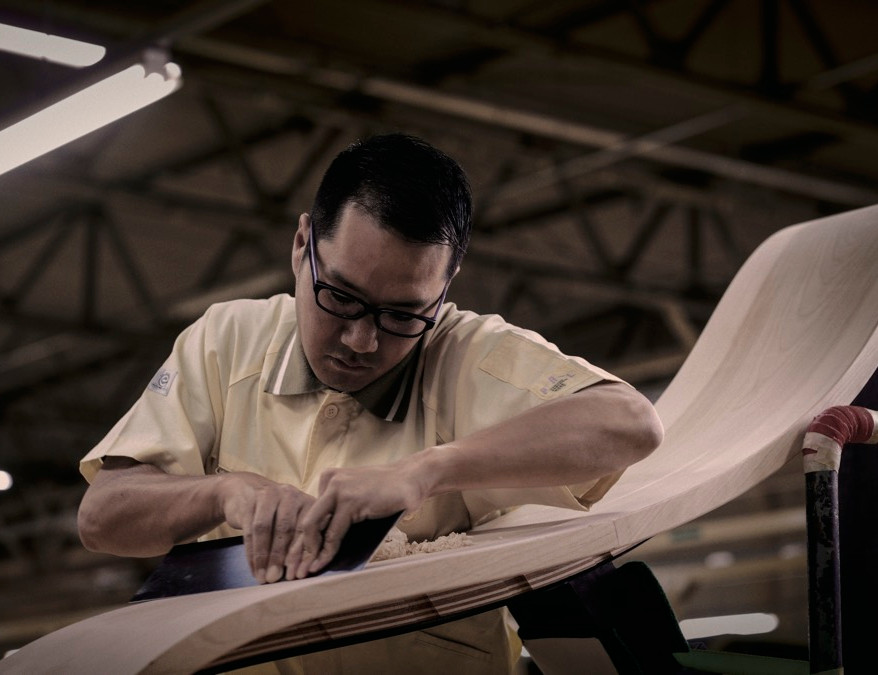 In building these 30 prototypes, what they found, what they changed may not seem like massive factors independently but collectively, they were pushing past that 80% mark… every point past 80 takes as much effort as the first 80. And so it’s these details – if you listen, if you pay attention, you’ll be aware that there’s more artistry, more musicality, more sustain, and ultimately more life in the new CFX. According to Heratch Touresian, Yamaha Technical and Product Specialist, “building upon the original CFX, we wanted to create a piano that has more control by the artist for subtle and nuanced playing, for shading and voicing. We also wanted to achieve better resonance and projection, giving a wider dynamic range. But projection is not an easy task with an acoustic instrument. You don’t simply turn the volume up or down. Concert grands are usually meant to be heard alongside an orchestra and fill a large room. But how do you project intimacy and warmth? It’s easy to make a piano more percussive to cut through the mix, but it’s no small feat to bring about presence for those listening from a distance but also up close to the piano.
In building these 30 prototypes, what they found, what they changed may not seem like massive factors independently but collectively, they were pushing past that 80% mark… every point past 80 takes as much effort as the first 80. And so it’s these details – if you listen, if you pay attention, you’ll be aware that there’s more artistry, more musicality, more sustain, and ultimately more life in the new CFX. According to Heratch Touresian, Yamaha Technical and Product Specialist, “building upon the original CFX, we wanted to create a piano that has more control by the artist for subtle and nuanced playing, for shading and voicing. We also wanted to achieve better resonance and projection, giving a wider dynamic range. But projection is not an easy task with an acoustic instrument. You don’t simply turn the volume up or down. Concert grands are usually meant to be heard alongside an orchestra and fill a large room. But how do you project intimacy and warmth? It’s easy to make a piano more percussive to cut through the mix, but it’s no small feat to bring about presence for those listening from a distance but also up close to the piano.
And so, the CFX underwent a process of implementing many changes, on the advice of 100+ concert pianists. One thing I thought was interesting was that Yamaha received input from concert pianists who aren’t necessarily Yamaha-specific artists. I think it takes real courage to listen to someone who says “I don’t like it” and then translate these abstract qualities into design ideas to make concrete substantive changes. This challenge was given to the Concert Piano Workshop of Yamaha, which is comprised of a team of a few dozen master builders at Yamaha’s factory. This Concert Workshop division contains the most skilled and experienced in their craft, the pinnacle of Yamaha’s creative work. Combined with the very best quality parts, the prototypes and R&D find their way to the stage. It’s a long process as it takes about 3 years from “farm to table” to produce a single concert grand at Yamaha.
The following is a brief list of what changes have gone on. We could actually speak of each of these items for hours (which I did with Mr. Touresian) but this is the brief outline of the improved components:
 Soundboard – The CFX Concert Grand contains a soundboard called the GPX (Grand Piano “X”). Thinking back to algebra, Solve for X. Well it seems at Yamaha, they solved that equation. The GPX is Yamaha’s proprietary method in predictive analysis of wood to know how to best shape or crown each soundboard, which is the heart and soul of any piano. It’s what creates the sound that envelopes you when sitting in front of the piano. It represents sustain, filtering unwanted frequencies and creates an elusive sense of presence. One recurring theme on the CFX Concert Grand (which we will get into a little later as well) is that the reduction of undue stress is paramount. With the reduction of stress, the soundboard vibrates uninhibited.
Soundboard – The CFX Concert Grand contains a soundboard called the GPX (Grand Piano “X”). Thinking back to algebra, Solve for X. Well it seems at Yamaha, they solved that equation. The GPX is Yamaha’s proprietary method in predictive analysis of wood to know how to best shape or crown each soundboard, which is the heart and soul of any piano. It’s what creates the sound that envelopes you when sitting in front of the piano. It represents sustain, filtering unwanted frequencies and creates an elusive sense of presence. One recurring theme on the CFX Concert Grand (which we will get into a little later as well) is that the reduction of undue stress is paramount. With the reduction of stress, the soundboard vibrates uninhibited.
Soundboards consist of a very large board made of spruce. On the under side of the soundboard there are perpendicular ribs that support and stiffen the board. Historically, soundboard manufacturing has contained crowned or lightly rounded shape to enhance vibration and projection. Problematic, however is that the ribs are flat. You’ve heard the expression, “Trying to fit a round peg into a square hole”. Gluing flat ribs to a round soundboard creates stress as the flat ribs will always be flexed to pull away from the crowned soundboard. Not so with the GPX soundboard where Yamaha developed not only a rounded soundboard but matching crowned ribs so that they act in unison. This process is very labor intensive. All of sudden, the ribs are not interchangeable. They must match the position of the crown in the soundboard. It takes the CF division about 6 months just to create a concert soundboard from cutting the log, to curing, air-dried, kiln-dried, shaping, and tapering. Yamaha owns its own wood mill. Their kiln is considered one of the largest in the world. After inspection of each cut of European spruce, typically only 10% is designated for soundboard use. Of that 10%, only 1% of it is used to create the speaking voice of the CFX grand pianos.
 Cast Iron Plate – Yamaha employs their own metallurgists. One thing, among many that separates Yamaha from other companies is that they can safely say “We are the supply chain”. What I mean by that is rather than relying on a separate company to make parts for them, they make their own parts. From agraffes, to tuning pins, milling machines and yes, even the cast iron plates are made in the Yamaha factory. Metallurgists are involved in sound design to create a more unified tone. The new sandcast plate is lighter, stripped of any extraneous decoration. It is bell-like, lighter with more organized harmonics. The bearings (areas where strings touch the plate) have been heat treated to reduce string “bite”. Interesting to note is that the alloys in the CFX are a special formula that the metallurgists have developed so that the harmonics are more compatible with the tone of the instrument. This traditional sand cast plate contains a hard surface with a softer core, balancing rigidity for strength with shock absorption at its center.
Cast Iron Plate – Yamaha employs their own metallurgists. One thing, among many that separates Yamaha from other companies is that they can safely say “We are the supply chain”. What I mean by that is rather than relying on a separate company to make parts for them, they make their own parts. From agraffes, to tuning pins, milling machines and yes, even the cast iron plates are made in the Yamaha factory. Metallurgists are involved in sound design to create a more unified tone. The new sandcast plate is lighter, stripped of any extraneous decoration. It is bell-like, lighter with more organized harmonics. The bearings (areas where strings touch the plate) have been heat treated to reduce string “bite”. Interesting to note is that the alloys in the CFX are a special formula that the metallurgists have developed so that the harmonics are more compatible with the tone of the instrument. This traditional sand cast plate contains a hard surface with a softer core, balancing rigidity for strength with shock absorption at its center.
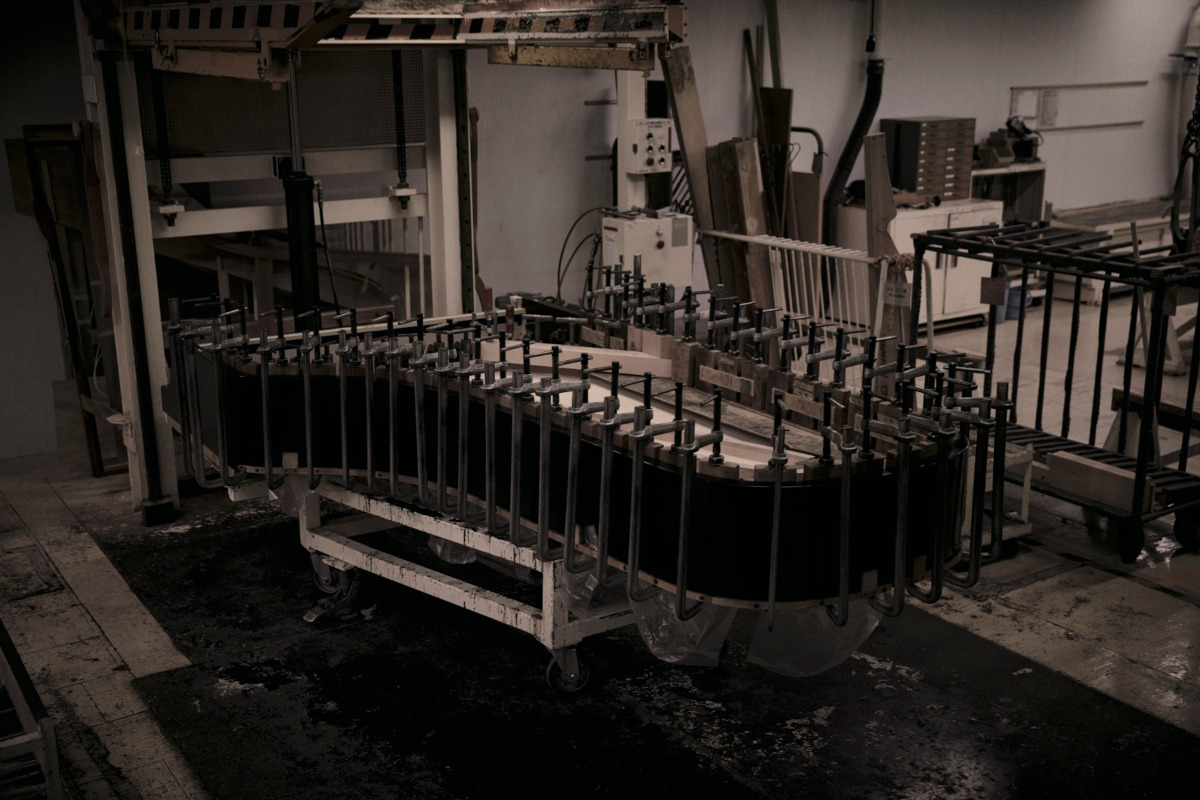 Rim – For the first time with Yamaha, both the outer and inner rims are pressed at the same time. Historically, the inner rim has been manufactured followed by the exterior rim. In this new method, the objective was to create better cohesion and unify the projection of tone. Minimal glue is used which inhibits the transference of tone.
Rim – For the first time with Yamaha, both the outer and inner rims are pressed at the same time. Historically, the inner rim has been manufactured followed by the exterior rim. In this new method, the objective was to create better cohesion and unify the projection of tone. Minimal glue is used which inhibits the transference of tone.
A.R.E. – Acoustic Resonance Enhancement – I find this a fascinating part of Yamaha’s piano design. We dedicated an article to this on Piano Price Point. In a nutshell, the rim of the piano has been “age enhanced” through the process of torrefaction. The result is a more resonant, reflective surface that reflects and filters tone to the soundboard. Yamaha is the only company in the world to employ this technique and this is the first time it’s been used on their CFX concert pianos. One of the reasons older instruments are so highly prized is that they become more resonant over years. Yamaha has age-enhanced their wood to an equivalent of 95 years!
Back post structure – To me, the most interesting part on the 2022 CFX is that the beams in the back-post structure are fitted together with such precision that glue is not actually required. With the beam structure, this new method of joinery is so precise, they press pieces together by hand. They are not banged into place with hammers. According to Heratch, “Those potentially create ‘bruises’ or places on the piano that inhibit tone where wood fibers at a molecular level are damaged. Like the human body, the thought process around design for the current CFX design is to consider everything to be tone producing. Why create damage when the ideal is to reduce inhibition to energy and music flow?”
The way they manage to simply press these large beams into place by hand is an ingenious method where the environmental humidity of the room is matched to the wood moisture content, in essence shrinking the wood to fit comfortably. After all the beams are in place, the beam construction is then raised back to normal humidity levels. Also interesting to note is that the center beam, the spine of the piano is bespoke to each piano to allow optimal tone transference. And while glue is not actually necessary, it is, in fact sparsely used. By the way, even the glue at Yamaha is a proprietary, non-chemical formula.
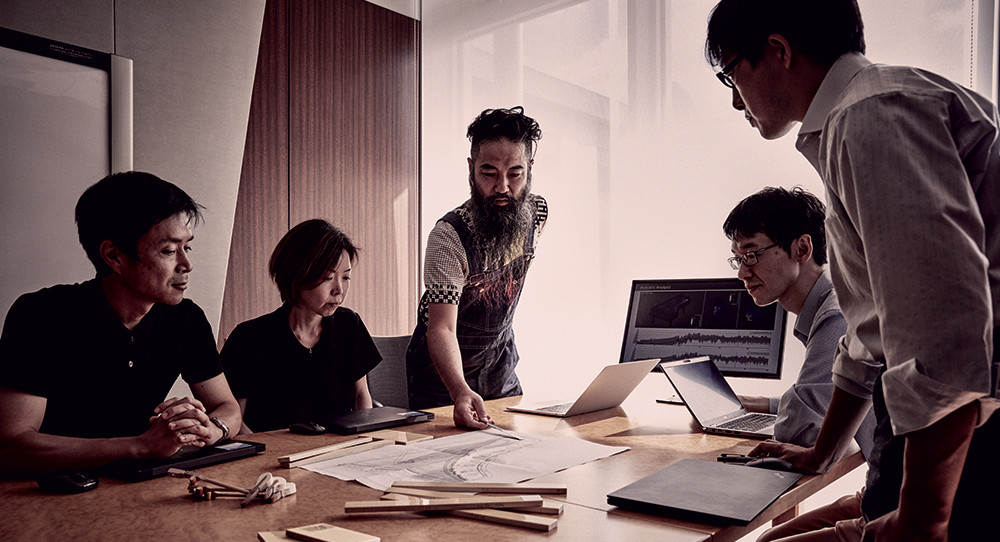 Re-Scaled Design – The blueprint of a piano is called a scale. The new CFX has had an all-new scale design which improves the overall tone and harmonics of the piano but specifically addresses the area of the piano more commonly known as the “killer zone”. Octaves 5 and 6 in any piano is often a manufacturing challenge to create a sense of projection and sustain in that area. The newly re-scaled CFX has moved the bridge further from the pianist and the bearing closer to the pianist which increases speaking length of the string to address this. In addition, the back-post structure has added new support ‘energy’ beams to reinforce this.
Re-Scaled Design – The blueprint of a piano is called a scale. The new CFX has had an all-new scale design which improves the overall tone and harmonics of the piano but specifically addresses the area of the piano more commonly known as the “killer zone”. Octaves 5 and 6 in any piano is often a manufacturing challenge to create a sense of projection and sustain in that area. The newly re-scaled CFX has moved the bridge further from the pianist and the bearing closer to the pianist which increases speaking length of the string to address this. In addition, the back-post structure has added new support ‘energy’ beams to reinforce this.
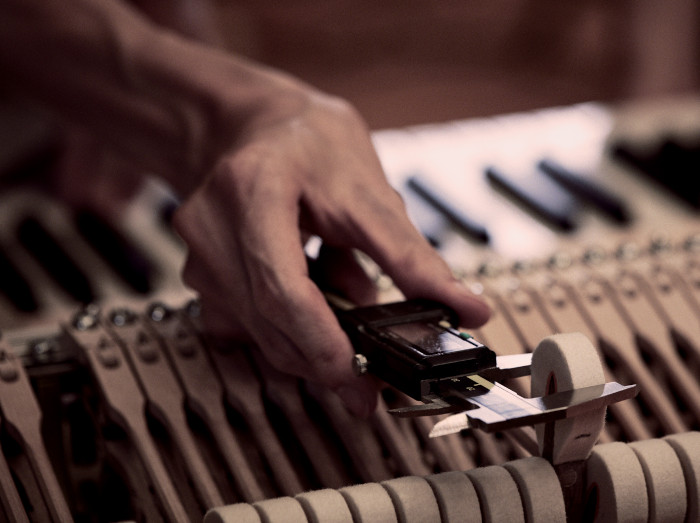 Action geometry – While the scale often refers to the master blueprint of the piano, the action geometry specifically refers to the mechanical moving parts that work between the keys and hammers. This complex series of levers directly affects our perception of touch. If the geometry isn’t accurate, the piano touch can feel too heavy or conversely, it can feel too light which results in feeling too ‘fly away’, where it feels like you don’t have control over the touch. The action on the newly designed CFX is somewhat lighter, and yet retains lightning speed return. One thing I noted is that the soft playing is incredibly responsive. You can’t ‘outplay’ the soft touch on the piano. It responds to every subtlety, every nuance and at just the hint of lifting your finger, it’s ready to repeat – a simply incredible sensation. Interesting to note is that the shanks – the dowels attached to the hammers have been specifically designed to have more flexibility in the bottom and less flexibility in the top end, which provides more “whip” to the blow of the hammer, allowing for wider dynamic spread.
Action geometry – While the scale often refers to the master blueprint of the piano, the action geometry specifically refers to the mechanical moving parts that work between the keys and hammers. This complex series of levers directly affects our perception of touch. If the geometry isn’t accurate, the piano touch can feel too heavy or conversely, it can feel too light which results in feeling too ‘fly away’, where it feels like you don’t have control over the touch. The action on the newly designed CFX is somewhat lighter, and yet retains lightning speed return. One thing I noted is that the soft playing is incredibly responsive. You can’t ‘outplay’ the soft touch on the piano. It responds to every subtlety, every nuance and at just the hint of lifting your finger, it’s ready to repeat – a simply incredible sensation. Interesting to note is that the shanks – the dowels attached to the hammers have been specifically designed to have more flexibility in the bottom and less flexibility in the top end, which provides more “whip” to the blow of the hammer, allowing for wider dynamic spread.
Hammers – The hammers on the new CFX are made with German FFW (Weickert) felt but have been filed less in the manufacturing stage.
Strings – The strings are comprised of German wire made by Röslau. With this new design, the piano wire is of the highest grade containing the lowest amount of impurities.
 Music rack – This is not just the latest in ‘snazzy’ designs by Yamaha. Often when I play a grand piano, I put the music rack down simply because it blocks the tone in front of you. Not so on this piano, the slots in the music rack have been not only optimized to hear more but also shaped so that the tone does not become out of phase when it’s in the upright position – a beautiful enhancement to their piano.
Music rack – This is not just the latest in ‘snazzy’ designs by Yamaha. Often when I play a grand piano, I put the music rack down simply because it blocks the tone in front of you. Not so on this piano, the slots in the music rack have been not only optimized to hear more but also shaped so that the tone does not become out of phase when it’s in the upright position – a beautiful enhancement to their piano.
A dozen years have passed since the introduction of the CFX in 2010 to the latest release in 2022. If there’s one thing Yamaha is known for, it’s the constant pursuit of excellence. Rather than living on the laurels of their work, they continued in their research & development. With 100 world class concert artists willing to offer input and 30 prototypes later, Yamaha quietly introduced the second iteration of the CFX. But these are not subtle changes. It’s a CFX PLUS all the changes implemented in the last 12 years. I think that the overlying theme that left an impression on me was that the CFX is an attempt to be “transparent” – to allow the vibration of the instrument to be uninhibited, that the flow-through of energy and sound waves culminates into presence, and presence, musicality. Each component scrutinized, evaluated to see if there is a more efficient path to transfer energy, reduce friction, filter sound through tone wood and create better sound production. It’s what Yamaha has crafted “A piano for your moment”. It’s the most significant piano Yamaha has made to connect the artist with the music.
Many thanks to Heratch Touresian for the many hours spent describing the new CFX in detail to me. Cheers!